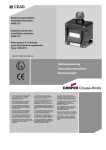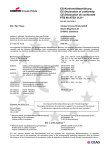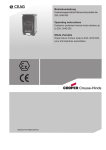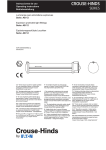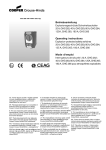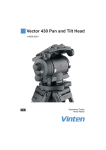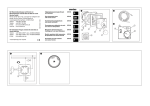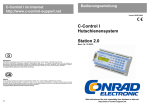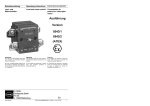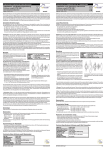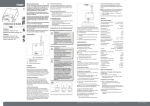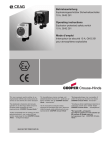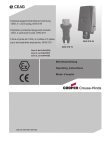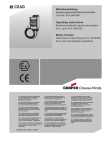Download GHG2707003P0001_N_5 Ex-Installationsschalter
Transcript
CROUSE-HINDS Betriebsanleitung Operating instructions Mode d’emploi SERIES Explosionsgeschützte Installationsschalter GHG 273 Explosion protected installation switches GHG 273 Interrupteur d’ éclairage pour atmosphères explosives GHG 273 GHG 270 7003 P0001 D/E/F (n) Explosionsgeschützte Installationsschalter Typ GHG 273 Explosion protected installation switches type GHG 273 Interrupteurs d’éclairage pour atmosphères explosives type GHG 273 Inhalt: Contents: Contenu: Inhalt........................................................ 2 Contents.................................................. 2 Contenu................................................... 2 Maßbild.................................................... 3 Dimensional drawings.............................. 6 Plans cotés............................................... 9 Anschlussbilder........................................ 3 Wiring diagrams....................................... 6 Schéma des connexions.......................... 9 1 Technische Angaben................................ 3 1 Technical Data.......................................... 6 1 Caractéristiques techniques.................... 9 2Sicherheitshinweise................................. 3 2 Safety instructions................................... 6 2 Consignes de sécurité............................. 9 3Normenkonformität.................................. 3 3 Conformity with standards....................... 6 3 Conformité avec les normes.................... 9 4Verwendungsbereich............................... 3 4 Field of application................................... 6 4 Domaine d’utilisation............................... 9 5 Verwendung / Eigenschaften................... 4 5 Use / Properties....................................... 7 5 Utilisation / Propriétés.............................10 6Installation................................................ 4 6Installation................................................ 7 6Installation...............................................10 6.1Montage................................................... 4 6.1Mounting.................................................. 7 6.1Montage..................................................10 6.2Öffnen des Gerätes / Elektrischer Anschluss............................. 4 6.2 Opening the device / Electrical connection................................ 7 6.2 Ouverture du dispositif / Raccordement électrique........................10 6.3Kabel- und Leitungseinführungen; Verschlussstopfen.................................... 5 6.3 Cable entries (KLE); blanking plug............................................ 8 6.3 Entrées de câble (KLE); bouchons de fermeture..........................11 6.4 Flansche und Metallplatten...................... 5 6.4 Flange and metal plates........................... 8 6.4 Plaques à brides......................................11 6.5 Schließen des Gerätes............................. 5 6.5 Closing the device / cover closure........... 8 6.5 Fermeture de l’appareil...........................11 6.6Inbetriebnahme........................................ 5 6.6 Taking into operation................................ 8 6.6 Mise en service.......................................11 7 Instandhaltung / Wartung......................... 5 8Reparatur / Instandsetzung / Änderungen............................................. 5 8 Repairs / Overhaul / Modification............................................. 8 8 Réparation / Remise en état........................................11 9 Entsorgung / Wiederverwertung.............. 5 7 Maintenance / Servicing........................... 8 9 Disposal / Recycling................................. 8 7 Maintien / Entretien................................11 9 Évacuation des déchets / Recyclage.......11 Konformitätserklärung separat beigelegt. 2 Declaration of conformity, enclosed separately. EATON’s Crouse-Hinds Business Déclaration de conformité, jointe séparément. Explosionsgeschützte Installationsschalter Typ GHG 273 1 Maßbilder in mm 64 55 85 X75 85 115 X52 5,6 6,7 Technische Angaben Gerätekennzeichnung nach 94/9/EG und Norm: EG-Baumusterprüfbescheinigung: Bemessungsspannung: Bemessungsstrom: Kurzschlussvorsicherung: Schaltvermögen EN 60947-4-1 AC 5a: Schaltvermögen EN 60947-4-2 AC 5b: Zulässige Umgebungstemperatur: (Abweichende Temperaturen sind bei Sonderversionen möglich) 53 20 64 55 85 X75 85 115 X52 5,6 6,7 35 20 GHG 273 Zul. Lagertemperatur in Originalverpackung: Schutzart nach EN/IEC 60529: Schutzklasse nach EN/IEC 61140: Leitungseinführung (Listenausführung): geeignete Leitungen und Prüfdrehmomente der Druckschraube Dichtung 1+2 1 2 min. max. (1)(2) Dichtung 2 min. 1 2 max. (2) Anschlussklemme: PE - Anschlussklemme: Prüfdrehmomente: Einschraubgewinde der KLE M25: Deckelschrauben: Anschlussklemmen: Gewicht (Listenausführung): (1) X = Befestigungsmaße Anschlussbilder Sicherheitshinweise -20° C bis +40° C IP 66 (Listenausführung) I - wird von den Geräten erfüllt 1 x M25 oder 2 x M 25 (Ø 10 -15 mm) 2 x Bohrung M20 Ø Nm 10,0 13,0 13,5 15,0 2 x 1,5 - 2,5 mm² 4 x 1,5 - 2,5 mm² 2,3 2,6 1,5 2,3 3,0 Nm 2,0 Nm 2,5 Nm ca. 0,32 kg Ausschalter 2-polig L(N) a Die Installationsschalter sind nicht für Zone 0 und Zone 20 geeignet. Es entspricht den aufgeführten Normen, in der separat beigelegten Konformitätserklärung. Sie sind bestimmungsgemäß in unbeschädigtem und einwandfreiem Zustand zu betreiben. Vor Inbetriebnahme müssen die Installationsschalter entsprechend der im Abschnitt 6 genannten Anweisung geprüft werden. L Taster 1S+1Ö L(N) Normenkonformität Das Betriebsmittel ist gemäß DIN EN ISO 9001:2008 und EN ISO/IEC 80079-34:2011 entwickelt, gefertigt und geprüft worden. Die Anforderungen der EN/IEC 60079-31, u.a. in Bezug auf übermäßige Staubablagerungen und Temperatur, sind vom Anwender zu beachten. Wechselschalter 1S+1Ö 3 Zielgruppe dieser Anleitung sind Elektrofachkräfte und unterwiesene Personen in Anlehnung an die EN/IEC 60079-14. Die auf den Installationsschaltern angegebene Temperaturklasse und Explosionsgruppe ist zu beachten. L D II 2 G Ex de II C T6 D II 2 D Ex tD A21 IP66 T 80° C PTB 98 ATEX 3121 bis 250 V; 50/60 Hz max. 16 A max. 20 A gL 230 V / 16 A 230 V / 16 A -20° C bis +40° C (Listenausführung) Die Prüfungen der Klemmbereiche und Prüfdrehmomente wurden mit Metalldornen durchgeführt. Bei der Verwendung von Leitungen mit unterschiedlichen Fertigungstoleranzen und Materialeigenschaften kann der Klemmbereich variieren. Bitte verwenden Sie im Zwischenbereich die Kombination aus Dichtung 1 + 2. (2) Bei der Wahl der Dichtungsgummis darauf achten, dass bei zukünftigen Wartungsarbeiten an der KLE, die Druckschraube nachgezogen werden kann. 2 L D Beachten Sie die nationalen Sicherheits- und Unfallverhütungsvorschriften und die nachfolgenden Sicherheitshinweise in dieser Betriebsanleitung, die wie dieser Text in Kursivschrift gefasst sind! Die Schaltfunktion wird nur mit aufgeschraubter Schalterwippe erreicht EATON’s Crouse-Hinds Business 4 Verwendungsbereich Die Installationsschalter sind zum Einsatz in explosionsgefährdeten Bereichen der Zonen 1 und 2 sowie der Zonen 21 und 22 gemäß EN/IEC 60079-10-1 und EN/IEC 60079-10-2 geeignet! Die eingesetzten Gehäusematerialien einschließlich der außenliegenden Metallteile bestehen aus hochwertigen Werkstoffen, die einen anwendungsgerechten Korrosionsschutz und Chemikalienresistenz in „normaler Industrieatmosphäre“ gewährleisten: – schlagfestes Polyamid – Edelstahl AISI 316 L Bei einem Einsatz in extrem aggressiver Atmosphäre, können Sie zusätzliche Informationen über die Chemikalienbeständigkeit der eingesetzten Kunststoffe bei Ihrer zuständigen Cooper Crouse-Hinds Niederlassung erfragen. 3 Explosionsgeschützte Installationsschalter Typ GHG 273 5 Bild 1 Gerätehalter Größe 1 Befestigungslöcher „B“ Verwendung / Eigenschaften Die Installationsschalter dienen zur Ein- und Ausschaltung von Lichtstromkreisen bis max. 16 A in explosionsgefährdeten Bereichen (siehe technische Daten). Temperaturklasse, Explosionsgruppe, zulässige Umgebungstemperatur, siehe technische Daten. Die Installationsschalter sind auch im „normalen Industriebereich“ verwendbar. für Wandund Gitterrinnenbefestigung Die Schaltwippe ist mit einem selbstleuchtenden Schild gemäß § 7 der Arbeitsstättenverordnung versehen und frei von radioaktiven Zusätzen. Angaben aus Punkt 3 und 4 sind bei der Verwendung zu berücksichtigen. B Andere als die beschriebenen Anwendungen sind ohne schriftliche Erklärung der Fa. Cooper Crouse-Hinds nicht zulässig. Beim Betrieb sind die in der Betriebsanleitung unter Punkt 7 genannten Anweisungen zu beachten. Die Verantwortung hinsichtlich bestimmungsgemäßer Verwendung dieser Installationsschalter unter Bezugnahme der in der Anlage vorhandenen Rahmenbedingungen (s. Technische Daten) liegt allein beim Betreiber. für Rohrbefestigung 6 Bild 2 Gehäuseunterteil - Einführung unten - Schaltersockel (nicht mit einem harten Gegenstand (z.B. Schraubendreher) betätigen) - PE-Anschluss unten Gehäusedeckel - Typenschild unten Installation Für das Errichten / Betreiben sind die relevanten nationalen Vorschriften (z.B. Betriebssicherheitsverordnung, Gerätesicherheitsgesetz in Deutschland) sowie die allgemein anerkannten Regeln der Technik maßgebend (EN/IEC 60079-14). Wird der Installationsschalter mit den Leitungseinführungen nach unten montiert, ist der Schaltereinsatz und der Gehäusedeckel um 180° zu drehen (siehe Bild 2). Der Installationsschalter ist zur Befestigung auf den CEAG-Gerätehaltern Größe 1 mittels selbstschneidende Schrauben geeignet (siehe Bild 1). Die betreffende Montageanleitung ist zu beachten. 6.2 Öffnen des Gerätes/ Elektrischer Anschluss Der elektrische Anschluss des Betriebsmittels darf nur durch Fachpersonal erfolgen. (EN/IEC 60079-14) Vor Öffnen der Geräte ist die Spannungsfreiheit sicherzustellen bzw. sind geignete Schutzmaßnahmen zu ergreifen. Die ordnungsgemäß abisolierten Anschlussleitungen der Kabel sind unter Berücksichtigung einschlägiger Vorschriften anzuschließen. Die Isolation der Anschlussleitungen muss bis an die Klemme heranreichen. Der Leiter selbst darf nicht beschädigt sein. Wird der Installationsschalter mit der Leitungseinführung nach unten montiert, ist Punkt 6.1 und Bild 2 zu beachten. Nach der Demontage des Schaltersockels, zur leichteren Einführung der Kabel und Leitungen, muss der Sockel vor dem elektrischen Anschluss wieder ordnungsgemäß montiert werden. Die minimal und maximal anschließbaren Leiterquerschnitte sind zu beachten (siehe technische Daten). Unsachgemäße Installation und Betrieb der Schalter kann zum Verlust der Garantie führen. Alle Schrauben und/oder Muttern der Anschlussklemmen, auch die der nicht benutzten, sind fest anzuziehen. 6.1 Bei übermäßigem Anziehen kann der Anschluss beeinträchtigt oder beschädigt werden. Montage Die Montage des Gerätes kann ohne Öffnen des Gehäuses erfolgen. Die Installationsschalter dürfen bei der Direktmontage an der Wand nur an den vorgesehenen Befestigungspunkten eben aufliegen. Die gewählte Schraube muss der Befestigungsöffnung angepasst sein (siehe Maßbild) und sie darf die Öffnung nicht beschädigen (z.B. Verwendung einer Unterlegscheibe). Das Gerät ist mit mindestens 2 Schrauben diagonal zu befestigen. Bei übermäßigem Anziehen der Befestigungsschrauben kann das Gerät beschädigt werden. 4 D EATON’s Crouse-Hinds Business Zur Aufrechterhaltung der Zündschutzart ist der Leiteranschluss mit besonderer Sorgfalt durchzuführen. Die Anschlussklemmen sind für den Anschluss von Kupferleitern ausgelegt. Bei der Verwendung von mehr- oder feindrähtigen Anschlusskabeln und Anschlussleitungen sind die Aderenden entsprechend den geltenden nationalen und internationalen Vorschriften zu behandeln (z.B. Verwendung von Aderendhülsen). Explosionsgeschützte Installationsschalter Typ GHG 273 6.4 Bild 3 Gehäuseunterteil PE Anschlussleitung Flansche und Metallplatten* Die für die Wartung / Instandhaltung von elektrischen Betriebsmitteln in explosionsgefährdeten Bereichen geltenden Bestimmungen wie EN/IEC 60079-17 sind einzuhalten. Der Metallflansch ist so zu montieren, dass die IP-Schutzart gewährleistet bleibt. Dabei ist auf die Unversehrtheit der Dichtung zu achten. Vor Öffnen des Gehäuses Spannungsfreiheit sicherstellen bzw. geeignete Schutzmaßnahmen ergreifen. Achtung: Beim Anziehen der Hutmutter der Metall – KLE (z.B. Typ ADE;) ist die Verschraubung mit einem geeigneten Werkzeug gegen Verdrehen zu sichern. Von außen herangeführte PE-Leitungen sind auf die dafür vorgesehene PE-Klemme am Flansch anzuschließen. Der maximale Anschlussquer-schnitt beträgt 6 mm². * z.Zt. nicht bescheinigt für Kategorie II D 6.3 Kabel-und Leitungseinführungen (KLE); Verschlussstopfen 6.5 Es dürfen generell nur bescheinigte KLEs und Verschlussstopfen verwendet werden. Für bewegliche Leitungen sind Trompetenverschraubungen oder andere geeignete Einführungen mit zusätzlicher Zugentlastung zu verwenden. Alle Fremdkörper sind aus dem Gerät zu entfernen. Die für die eingesetzten KLE maßgebenden Montagerichtlinien sind zu beachten. Um die Mindestschutzart herzustellen, sind nicht benutzte Einführungsöffnungen mit einem bescheinigten Verschlussstopfen zu verschließen. Es ist darauf zu achten, dass bei der Installation der KLE die für den Leitungsdurchmesser geeigneten Dichtungseinsätze verwendet werden. Bei ausschneidbaren Dichtungseinsätzen ist sicherzustellen, dass der Einsatz ordnungsgemäß dem Leitungsdurchmesser angepasst wird. Zur Sicherstellung der erforderlichen Mindestschutzart sind die KLE fest anzuziehen. Zur Sicherstellung der erforderlichen Mindestschutzart sind die Deckelschrauben fest anzuziehen. Bei übermäßigem Anziehen kann die Schutzart beeinträchtigt werden. 6.6 Die erforderlichen Wartungsintervalle sind anwendungsspezifisch und daher in Abhängigkeit von den Einsatzbedingungen vom Betreiber festzulegen. Im Rahmen der Wartung sind vor allem die Teile, von denen die Zündschutzart abhängt, zu prüfen (z.B. Unversehrtheit der druckfesten Komponenten, des Gehäuses, der Dichtungen und der Kabel- und Leitungseinführungen). Sollte bei einer Wartung festgestellt werden, dass Instandsetzungsarbeiten erforderlich sind, ist Abschnitt 8 dieser Betriebsanleitung zu beachten. Schließen des Gerätes Der Gehäusedeckel ist so aufzusetzen, dass der Schutzkragen oben ist. Beim Einsatz von KLE mit einer niedrigeren als der für das Gerät zutreffenden IP-Schutzart, (siehe Seite 3, technische Daten) wird die IP-Schutzart des gesamten Gerätes reduziert. Instandhaltung / Wartung Müssen Metallflansche demontiert werden (z.B. zum Bohren von Einführungsöffnungen), ist bei der Montage zur Aufrechterhaltung der Mindestschutzart auf den korrekten Sitz der Flansche zu achten (siehe Bild 3). Achtung: Metallflansche, Metallplatten und Metallverschraubungen müssen in den Potentialausgleich miteinbezogen werden. Metallflansch für Metalleinführungen 7 D Inbetriebnahme Vor Inbetriebnahme des Betriebsmittels sind die in den einzelnen nationalen Bestimmungen genannten Prüfungen durchzuführen. Außerdem ist vor der Inbetriebnahme die korrekte Funktion und Installation des Betriebsmittels in Übereinstimmung mit dieser Betriebsanleitung und anderen anwendbaren Bestimmungen zu überprüfen. Die Stößel des Schaltersockels nicht zum Testen mit einem harten Gegenstand (z.B. Schraubendreher) betätigen. Unsachgemäße Installation und Betrieb der Installationsschalter kann zum Verlust der Garantie führen. 8 Reparatur / Instandsetzung / Änderungen Instandsetzungsarbeiten / Reparaturen dürfen nur Originalteile von CEAG / Cooper CrouseHinds (nachfolgend CCH) verwendet werden. Bei Schäden an der druckfesten Kapselung ist nur ein Austausch zulässig. Im Zweifelsfalle ist das betroffene Betriebsmittel an CCH zur Reparatur zurückzugeben. Reparaturen, die den Explosionsschutz betreffen, dürfen nur von CCH oder einer qualifizierten Elektrofachkraft in Übereinstimmung mit national geltenden Regeln durchgeführt werden (EN/IEC 60079-19). Umbauten oder Änderungen am Betriebsmittel sind nicht gestattet. Ausgenommen ist das Anbringen von zusätzlichen KLE im Rahmen der Zulassung des Betriebsmittels. 9 Entsorgung / Wiederverwertung Bei der Entsorgung des Betriebsmittels sind die jeweils geltenden nationalen Abfallbeseitigungsvorschriften zu beachten. Bei übermäßigem Anziehen kann die Schutzart beeinträchtigt werden. Alle nicht benutzten metrischen CEAG KLE sind mit dem bescheinigten CEAG-Verschluss für metrische KLE zu verschließen. Zur Erleichterung der Wiederverwertbarkeit von Einzelteilen sind Kunststoffteile mit dem Kennzeichen des verwendeten Kunststoffes versehen. Programmänderungen und -ergänzungen sind vorbehalten. EATON’s Crouse-Hinds Business 5 Explosions protected installation switches type GHG 273 1 Dimensions in mm 64 55 85 X75 85 115 X52 5.6 6.7 Technical data Marking acc. to 94/9/EC and directive: EC type examination certificate: Rated voltage: Rated current: Short circuit back-up fuse: Switching capacity EN 60947-4-1 AC 5a: Switching capacity EN 60947-4-2 AC 5b: Perm. ambient temperature: (Special versions permit deviating temperature ranges) 53 20 64 55 85 X75 85 115 X52 5.6 6.7 35 20 GHG 273 X = Fixing dimensions Perm. storage temperature in original packing: Protection category acc. to EN/IEC 60529: Insulation class acc. to EN/IEC 61140: Cable entry (catalogue version): suitable cables and test torques of the pressure srew seel 1+2 1 2 min. max. (1)(2) seel 2 min. 1 2 max. (2) Supply terminal: PE-terminal: Test torques: Test torque for screw in thread cable entry Cover screws Terminals Weight (catalogue version): Safety instructions The operations must be carried out by electrical suitably trained in hazardous area with knowledge of increased safety explosion protection IEC/EN 60079-14. Wiring diagrams The installation switches are not suitable for Zone 0 and Zone 20 hazardous areas. On-Off switch 2-pole Push button switch 1S+1Ö L(N) L They shall be used for their intended purpose and in perfect and clean condition. Prior to taking the installation switches into operation, they shall be checked in accordance with the instruction as per section 6. L(N) The switch function is only realized with closed enclosure cover 6 The temperature class and explosion group marked on the installation switches shall be observed. The requirements of the IEC/EN 60079-31 regarding excessive dust deposits and temperature to be considered from the user. L -20° C up to +40° C IP 66 ( catalogue version) I - is complied with by the installation switches 1 x M25 or 2 x M25 (Ø 10 - 15 mm) 2 x drilling M20 Ø Nm 10.0 13.0 13.5 15.0 2 x 1.5 - 2.5 mm² 4 x 1.5 - 2.5 mm² 2.3 2.6 1.5 2.3 3.0 Nm 2.0 Nm 2.5 Nm approx. 0.32 kg The tests of clamping ranges and torque values were performed with metal mandrel. The clamping range can vary by using cables with different manufacturing tolerances and material properties. Please use the combination of sealing 1 + 2 for the intermediate region. (2) When selecting the seal rubber, ensure that the pressure screw can be tightened when carrying out any future maintenance work on the cable entry. a Change over switch 1S+1Ö D II 2 G Ex de II C T6 D II 2 D Ex tD A21 IP66 T 80° C PTB 98 ATEX 3121 up to 250 V; 50/60 Hz max. 16 A max. 20 A gL 230 V / 16 A 230 V / 16 A -20° C up to +40° C (catalogue version) (1) 2 L GB Observe the national safety rules and regulations for prevention of accidents as well as the safety instructions included in these operating instructions and set in italics the same as this text! EATON’s Crouse-Hinds Business 3 Conformity with standards Das Betriebsmittel ist gemäß DIN EN ISO 9001:2008 und EN ISO/IEC 80079-34:2011 entwickelt, gefertigt und geprüft worden. Es entspricht den aufgeführten Normen, in der separat beigelegten Konformitätserklärung. 4 Field of application The installation switches are suitable for use in Zones 1 and 2 as well as in Zones 21 and 22 hazardous areas acc. to IEC/EN 60079-10-1 and IEC/EN 60079-10-2! The enclosure materials employed, including the exterior metal parts, are made of highquality materials which ensure a corrosion protection and resistance to chemical substances corresponding to the requirements in a “normal industrial atmosphere”: – impact resistant polyamide – special steel AISI 316 L In case of use in an extremely aggressive atmosphere, please refer to manufacturer. Explosions protected installation switches type GHG 273 5 Fig. 1 Size 1 apparatus holder Fastening holes “B” Use / Properties The installation switches are designed for switching on and off light circuits in hazardous areas up to 16 A (see technical data). The temperature class, explosion group and permissible ambient temperature, see technical data. The installation switches can also be used in a ”normal industrial area“. for walland channel fixing The switch rocker is provided with a luminescent label in acc. with § 7 of the Workshop regulations and free from any radioactive additives. The data as per point 3 and 4 shall be taken into account with the use. B Applications other than described are not permitted without Cooper Crouse Hinds prior written consent. For the operation, the instructions stated in section 7 of the operating instructions shall be observed. The user alone is responsible for the appropriate use of this installation switch in consideration of the basic conditions existing at the plant (see technical data). for pipe fixing 6 Fig. 2 Enclosure base - entry from bottom side - Installation For the mounting and operation, the respective national regulations (e. g. Betr.Si.V., equipment safety law for Germany) as well as the general rules of engineering shall be observed (IEC/EN 60079-14). The improper installation and operation of switches may result in the invalidation of the guarantee. 6.1 Mounting The installation switches can be mounted without opening their enclosure. Switch basel (Testing the switch socket with a hard object (screwdriver) is not permitted.) - PE-terminal on the bottom Enclosure cover - type label on bottom In case the switches are mounted directly onto the wall, they may rest evenly only at the respective fastening points. The chosen screw shall match the fastening hole (see dimensional drawing) and it must not damage the hole (e. g. use of a washer). The device shall be fastened diagonally with at least 2 screws. GB The installation switch is suitable for fixing onto CEAG apparatus holders size 1 by means of self-cutting screws (see fig. 1). The respective mounting instructions shall be observed. 6.2 Opening the device / Electrical connection The electrical connection of the device may only be carried out by skilled staff (IEC/EN 60079-14). Before opening the apparatus, ensure that it has been isolated from the voltage supply, or take appropriate protective measures. Taking into account the respective regulations, the properly bared conductors of the cables shall be connected. The insulation of the conductors shall reach up to the terminal. The conductor itself shall not be damaged. If the installation switch is mounted with the cable entries on bottom, point 6.1 and fig. 2 will have to be observed. After dismantling the switch base in order to facilitate the introduction of cables, such switch base will have to be properly fitted in again prior to the electrical connection. The connectible min. and max. conductor cross-sections will have to be observed (see technical data). All screws and/or nuts of the supply terminals, also of those remaining vacant, shall be tightened down. Excessive tightening may affect or damage the connection. The conductors shall be connected with special care in order to maintain the explosion category. The supply terminals are designed for the connection of copper conductors. If multi- or fine-wire connecting cables are used, the wire ends will have to be handled in acc. with the applicable national and international rules (e. g. use of ferrules). If the screws are overtightened, the apparatus can be damaged. When the installation switch is mounted with the cable entries on bottom side, the switch insert and the enclosure cover must be turned through 180° (see fig.2). EATON’s Crouse-Hinds Business 7 Explosions protected installation switches type GHG 273 6.4 Fig. 3 Enclosure base PE-connection Flange and metal plates* The relevant national regulations which apply to the maintenance/servicing of electrical apparatus in explosive atmospheres, shall be observed (e. g. IEC/EN 60079-17). Flange plates shall be fitted so that the IP protection in maintained. Pay attention to the proper seat of the sealing. Before opening the enclosure make sure that the apparatus is disconnected from the voltage, or take the appropriate protective measures. Attention: When tightening the cap nut of the metal cable entry (e.g.type ADE; CMDEL), the screwing is to be protected against twisting by means of a suitable tool. PE conductors fed from outside are to be connected to the PE terminal provided on the flange. The maximum cross-section is 6 mm² category. 6.3 Cable entries (KLE); blanking plugs Generally, only certified cable entries and blanking plugs are permitted for use. Flexible cables shall be used with trumpetshaped cable glands or other suitable entries with additional pull-relief. * not yet certified for category II D 6.5 The enclosure cover shall be fitted so that the protective collar is on the upper part. Any foreign matter shall be removed from the apparatus. In order to ensure the required minimum protection category, the cover screws are to be tightened down. The mounting directives applicable to the cable entries used shall be observed. Overtightening might impair the protection category. Unused holes shall be closed with a certified blanking plug in order to establish the minimum protection category. In case of sealing inserts that are cut out, it shall be ensured that the insert is properly adapted to the cable diameter. 6.6 In order to ensure the required minimum protection category, the cable glands are to be tightened down. Overtightening might impair the protection. All vacant metric CEAG cable entries shall be closed with the certified CEAG blanking plug for metric cable entries. The required maintenance intervals depend on the respective application and will therefore have to be determined by the user dependent on the conditions of use. When servicing the apparatus, particularly those parts that are decisive for the type of protection against explosion, will have to be checked (e. g. intactness of flameproof enclosed components, enclosure, cable glands, efficacy of the cover gaskets). If during servicing repairs prove to be necessary, section 8 of these operating instructions will have to be observed. Closing the device / cover closure When using cable entries with a lower IP protection than that which applies to the device (see page 6, technical data), the IP protection of the whole device will be reduced. Care has to be taken that when fitting the cable entries, sealing inserts appropriate to the cable diameter are used. Maintenance / Servicing If flange plates have to be removed in case of installation switches (e.g. for drilling entry holes), attention shall be paid to the proper fit of the flange plate when mounting them in order to maintain the minimum protection category (see fig. 3). Attention: Metal flanges, metal plates and metal cable glands shall be included in the equipotential earth connection. Metal flange for metal cable glands 7 GB Taking into operation Prior to taking the apparatus into operation, the tests specified in the relevant national regulations will have to be carried out. Apart from that, the correct functioning and installation of the apparatus in accordance with these operating instructions and other applicable regulations will have to be checked. Testing the switch socket with a hard object (screwdriver) is not permitted. Incorrect installation and use of the installation switches can invalidate the guarantee. 8 Repairs / Overhaul / Modification Repairs may only be carried out with genuine CCH/CEAG spare parts. In case of a damaged flameproof enclosure, only its replacement is permitted. In case of doubt, the respective apparatus will have to be returned for repair to CCH/CEAG. Repairs that affect the explosion protection, may only be carried out by CCH/CEAG or a qualified electrician in compliance with the applicable national rules (e. g. IEC/EN 60079-19). Modifications to the apparatus or changes of its design are not permitted. Except for the mounting of additional cable entries in accordance with the approval of the apparatus. 9 Disposal / Recycling When the apparatus is disposed of, the respective national regulations on waste disposal will have to be observed. In order to facilitate the recycling of individual components, plastic parts have been provided with the identification mark of the plastic material used. Subject to modifications or supplement of the product range. 8 EATON’s Crouse-Hinds Business Interrupteurs d’éclairage pour atmosphères explosives type GHG 273 1 Dimensions en mm 64 55 85 X75 85 115 X52 5,6 6,7 53 64 55 85 X75 85 115 X52 5,6 6,7 35 Caractéristiques techniques Marquage selon 94/9/CE et directive: Attestation d’examen CE de type: Tension nominale: Courant nominal: Fusible maximal de court-circuit adm. placé en amont: Puissance de coupure EN 60947-4-1 AC 5a: Puissance de coupure EN 60947-4-2 AC 5b: Température ambiante admissible: (Autres températures possibles avec des modèles spéciaux) 20 20 GHG 273 X = dimensions de fixation F Temp. de stockage dans l’emballage d’origine: Indice de protection selon EN/CEI 60529: Classe d’isolation selon EN/IEC 61140: Entrée de câble (modèle de liste): câbles appropriés et couples d’essai de la vis de pression phoque 1+2 1 2 min. max. (1)(2) phoque 2 min. 1 2 max. (2) Bornes de connexion: Borne du conducteur de protection: Couples d’essai: Couple d' essai pour l’entrée de câble Vis du couvercle Bornes Poids à vide (modèle de liste): D II 2 G Ex de II C T6 D II 2 D Ex tD A21 IP66 T 80° C PTB 98 ATEX 3121 jusqu’à 250 V; 50/60 Hz 16 A maxi 20 A gL maxi 230 V / 16 A 230 V / 16 A -20° C à +40° C(modéle de liste) -20° C à +40° C IP 66 (modéle de liste) I - est remplie par les interrupteurs d’éclairage 1 x M25 / 2 x M25 (Ø 10 - 15 mm) 2 x persaçe M20 Ø Nm 10,0 13,0 13,5 15,0 2 x 1,5 - 2,5 mm² 4 x 1,5 - 2,5 mm² 2,3 2,6 1,5 2,3 3,0 Nm 2,0 Nm 2,5 Nm env. 0,32 kg (1) Les tests des plages de serrage et les valeurs de couple de serrage ont été réalisés avec un mandrin métallique. La plage de serrage peut varier légèrement selon le type de câble et les propriétés des matériaux utilisés. Pour la zone intermédiaire, veuillez utiliser la combinaison des bagues d'étanchéité 1 + 2. (2) Lors de la sélection des bagues d’étanchéité au moment de l’installation, il faut s’assurer qu’il reste une marge de serrage suffisante au niveau du chapeau du presse étoupe. Cela permettra de pouvoir resserrer le presse étoupe lors d’une future maintenance. 2 Consignes de sécurité Les interrupteurs d’éclairage ne conviennent pas à l’emploi dans la zone 0, zone 20. Le groupe d’explosion et la classe de température indiqués sur les appareils devront être respectés. a Schéma des connexions Seuls des interrupteurs d’éclairage intacts et sans défaut de fabrication devront être employés pour la fonction qui leur est dévolue. Commutateur disjoncteur à 2 pôles L(N) L Commutateur inverseur 1 contact de travail + 1 contact de repos Bouton-poussoir 1 contact de travail + 1 contact de repos Avant la mise en service, les interrupteurs d’éclairage doivent être vérifiées selon l’instruction donnée dans la section 6. L L Les exigences des CEI/EN 60079-31 en ce qui concerne des dépôts de poussière démesurés et une température doivent être considérées par I’utilisateur. Respectez les prescriptions nationales de sécurité et de prévention contre les accidents ainsi que les consignes de sécurité énumérées en italique dans ce mode d’emploi. L(N) 3 Conformité avec les normes Les Appareils ont été conçues, fabriquées et contrôlées suivant DIN EN ISO 9001:2008 et EN ISO/IEC 80079-34:2011. Les Appareils sont conformes aux normes reprises dans la déclaration de conformité. 4 Domaine d’utilisation Les interrupteurs d’éclairage conviennent à l’emploi en zones 1 et zones 2 ainsi que l’emploi en zones 21 et zones 22 d’une atmosphère explosive selon CEI/EN 60079-10-1 et CEI/EN 60079-10-2. Pour l’enveloppe, y compris les pièces métalliques extérieures, des matières de qualité supérieure ont été employées. Elles assurent une protection appropriée contre la corrosion et une résistance contre des agents chimiques en “atmosphère industrielle normale”: – polyamide anti-choc – acier spécial AISI 316 L. En cas d‘utilisation en atmosphère extrèmement corrosive, vous pouvez obtenir des informations complémentaires sur la résistance chimique des plastiques utilisés chez la succursale Cooper Crouse-Hinds de votre région. La fonction de commutateur est seulement réalisé avec enceinte fermée couvrir EATON’s Crouse-Hinds Business 9 Interrupteurs d’éclairage pour atmosphères explosives type GHG 273 5 Fig. 1 Porte-appareils taille 1 Trous de fixation ”B“ pour fixation au mur et à la rainure de grille Utilisation / Propriétés Les interrupteurs d’éclairage servent à enclencher et déclencher des circuits d’éclairage jusqu’à 16 A maxi en atmosphère explosive (voir les caractéristiques techniques). Quant à la classe de température, le groupe d’explosion et la température ambiante admissible, voir les caractéristiques techniques. Les interrupteurs d’éclairage peuvent aussi être employées en ”atmosphère industrielle normale“. L’actionneur est pourvu d’une étiquette luminescente qui, selon le §7 du règlement pour des lieux d’utilisation, est libre des substances radioactives. B Pour l’utilisation, les consignes des sections 3 et 4 devront être respectées. Des emplois autres que ceux décrits ne sont admis qu’avec l’approbation écrite de CEAG. Lors de l’exploitation, les instructions selon point 7 de ce mode d’emploi doivent être respectées. pour fixation au tube Seul l’utilisateur est responsable de l’emploi conforme de interrupteur d’éclairage, en tenant compte des conditions générales exposées dans la notice (voir Caractéristiques techniques). 6 Fig. 2 Embase - entrée par le bas - Installation Pour l’installation et l’exploitation de ces appareils, la règlementation nationale en vigueur (en Allemagne par ex. Betr.Si.V., réglementation de sécurité des appareils) ainsi que les règles de la technique généralement reconnues devront être respectées (CEI/EN 60079-14). L’installation ou l’utilisation incorrecte de ces interrupteurs d’éclairage à bornes peut entraîner la perte de la garantie. Socle d’interrupteur (Test de la prise de l'interrupteur avec un objet dur (tournevis) ne est pas autorisée.) - Connexion à la terre en bas Couvercle - Etiquette de repérage en bas 6.1 Montage Le montage de l’appareil peut se faire sans ouvrir l’enveloppe. En cas de montage direct sur un mur, les interrupteurs d’éclairage ne doivent reposer que sur les points de fixation prévus. La vis choisie doit être en rapport avec le trou de fixation (voir plan coté) et elle ne doit pas endommager le trou (par ex. emploi d’une rondelle). L’appareil doit être fixé en diagonale avec au moins 2 vis. Si les vis sont forcées, il est possible que l’appareil soit endommagé. 10 EATON’s Crouse-Hinds Business F Si l’interrupteur d’éclairage est monté avec les entrées de câble dirigées vers le bas, l’insert de commutation et le couvercle de l’enveloppe doivent être tournés de 180° (voir fig. 2). L’interrupteur d’éclairage convient à un montage sur les plaques de montage CEAG taille 1, avec vis autotaraudeuses(voir fig. 1). Les instructions pour le montage devront être respectées. 6.2 Ouverture du dispositif / Raccordement électrique Le raccordement électrique du dispositif ne doit être éffectué uniquement par une personne qualifiée (CEI/EN 60079-14). Avant ouverture de l’enveloppe, mettre l’appareil hors-tension et prendre les mesures préventives appropriées. En tenant compte des règlements respectifs, les conducteurs dûment dénudés des câbles sont raccordés. L’isolation doit couvrir le conducteur jusqu’à la borne. Le conducteur lui-même ne doit pas être endommagé. Si l’interrupteur d’éclairage est monté de telle manière que les entrées de câble se trouvent en bas, il faudra respecter les prescriptions de l’alinéa 6.1 et correspondre à la fig. 2. Si des composants ont été retirés pour faciliter l’introduction des câbles, ceux-ci devront être remis dûment en place avant le raccordement électrique. Les sections minimales et maximales admissibles des conducteurs doivent être respectées (voir caractéristiques techniques). Toutes les vis et/ou écrous des bornes de connexion, ainsi que celles des bornes non utilisées, doivent être serrées à fond. Un serrage excessif des vis peut endom-mager l’appareil. Afin de maintenir le mode de protection, la connexion des conducteurs doit se faire très soigneusement. Les bornes sont prévues pour le raccordement de conducteurs en cuivre. En cas d’utilisation des câbles de connexion multifilaires ou à fils de faible diamètre, les extrémités des conducteurs doivent être traités selon la règlementation nationale et internationale en vigueur (par ex. emploi des embouts). Interrupteurs d’éclairage pour atmosphères explosives type GHG 273 6.4 Fig. 3 Embase Connexion à la terre Plaques à brides* Si les plaques à brides doivent être démontées (pour percage d’entrées de câble, par exemple) il faudra veiller lors du montage au maintien de l’indice de protection en replacant correctement la plaque (voir fig. 3). Les plaques à brides sont montées de telle façon à ce que l’indice de protection IP soit respecté. Il faut également veiller au bon état du joint d’étanchéité. Attention: les brides et plaques de fond métalliques et les presse-étoupe métalliques doivent être reliés au même potentiel. brides métalliques pour entrée de câble métallique 6.3 Entrées de câble (KLE) / Bouchons de fermeture De manière générale, seuls des bouchons obstruateurs et des entrées de câble certifiés doivent être utilisés. Pour des câbles flexibles il faudra utiliser des presse-étoupes en forme de trompette ou d’autres entrées appropriées avec décharge de traction supplémentaire. Lorsque des entrées de câble avec un indice de protection IP inférieur à celui du dispositif ont employées (voir page 9), l’indice de protection IP de l’ensemble sera réduit. Les directives pour le montage applicables aux entrées de câble montées doivent être respectées. Les entrées non utilisées doivent être fermées avec un bouchon obstruateur certifié pour établir l’indice de protection minimum. Lors du montage des entrées de câble il faudra veiller à ce que des joints d’étanchéité correspondant au diamètre du câble soient utilisées. Si des joints devaient être découpés sur mesure, il faudra veiller à ce que ceux-ci soient adaptés au diamètre du câble. Les entrées de câble doivent être serrées à fond pour conserver l’indice de protection minimum. 7 F Maintien/Entretien La règlementation nationale en vigueur pour le maintien et l’entretien du matériel électrique pour atmosphère explosive devra être respectée (CEI/EN 60079-17). Avant d’ouvrir l’enveloppe, débrancher le dispositif de la tension ou prendre des mesures préventives appropriées. Les intervalles de service requis dépendent de l’emploi spécifique et devront donc être fixés par l’utilisateur en tenant compte des conditions d’exploitation. Attention: Lors du serrage de l'écrou borgne de l'entrée de câble métallique (par ex. du type ADE; CMDEL), il faut veiller à ce que le presse-étoupe ne se torde. Pour ce faire, le mieux est d'utiliser un outil approprié. Lors de l’entretien des appareils et surtout des composants qui sont essentiels à la protection contre l’explosion, devront être vérifiés (par ex. intégrité des composants antidéflagrants, de l’enveloppe, des joints d’étanchéité et des entrées de câble). Des conducteurs PE amenés de l’extérieur doivent être connectés à la borne PE prévue à cet effet sur la bride. La section maximale est de 6 mm². Si, lors d’une inspection technique, on constate que des travaux d’entretien sont nécessaires, il faudra suivre le point 8 de ce mode d’emploi. * pour le moment, pas encore certifié Catégorie II D 6.5 Fermeture de l’appareil Le couvercle doit être posé de telle manière sur l’enveloppe que le collet protecteur se trouve en haut. Tout corps étranger doit être ôté de l’appareil. Les vis de couvercle doivent être serrées à fond afin de maintenir l’indice de protection minimum. Si les vis sont forcées, cela peut être nuisible à l’indice de protection. 6.6 Mise en service Avant la mise en service du matériel, les vérifications spécifiées dans les règlements nationaux individuels devront être exécutées. De plus, il faudra vérifier son fonctionnement et installation corrects en conformité avec ce mode d’emploi et avec d’autres règlements y applicables. Test de l’interrupteur socket avec un objet dur (tournevis) n’est pas autorisée. L’installation et l’exploitation inadéquates des fiches et prises peuvent entraîner la perte de la garantie. 8 Réparations / Remise en état Des réparations ne doivent être exécutées qu’à l’aide des pièces de rechange d’origine CEAG. En cas de défauts sur l’enveloppe antidéflagrante, seul un remplacement sera admis. Dans le doute, l’appareil défectueux devra être retourné à CEAG pour être réparé. Des réparations relatives à la protection contre l’explosion même, ne devront être exécutées que par CEAG ou par un électricien qualifié et en conformité avec la règlementation nationale en vigueur (CEI/EN 60079-19). Toute modification ou transformation de ces appareils est interdite. Seul le montage d'entrées de câble supplémentaires en conformité avec l’homologation des appareils est accepté. 9 Évacuation des déchets / Recyclage Lors de l’évacuation de ce matériel électrique, la règlementation nationale respective en vigueur devra être respectée. Pour faciliter la réutilisation des composants individuels, des pièces en matière plastique ont été repérées de la marque distinctive de la matière plastique employée. Au cas où elles seraient forcées, cela pourrait porter préjudice à l’indice de protection. Toutes les entrées de câble métriques CEAG non utilisées doivent être fermées avec un bouchon obsturateur certifié pour des entrées de câble métriques. Sous réserve de modification ou d’informations supplémentaires. EATON’s Crouse-Hinds Business 11 CZ: "Tento návod k použití si m žete vyžádat ve svém mate ském jazyce u p íslušného zastoupení spole nosti Cooper CrouseHinds/CEAG ve vaší zemi." H: "A kezelési útmutatót az adott ország nyelvén a Cooper Crouse-Hinds/CEAG cég helyi képviseletén igényelheti meg." P: "Se for necessária a tradução destas instruções de operação para outro idioma da União Europeia, pode solicita-la junto do seu representante Cooper Crouse-Hinds/CEAG" DK: "Montagevejledningen kan oversættes til andre EU-sprog og rekvireres hos Deres Cooper Crouse-Hinds/CEAG leverandør" I: "Se desiderate la traduzione del manuale operativo in un´altra lingua della Comunit à Europea potete richiederla al vostro rappresentante Cooper Crouse-Hinds/CEAG" PL: Niniejsz instrukcj obs ugi w odpowiedniej wersji j zykowej mo na zamówi w przedstawicielstwie firmy Cooper-CrouseHinds/CEAG na dany kraj. LT: Šios naudojimo instrukcijos, išverstos J su gimt j kalb , galite pareikalauti atsakingoje "Cooper Crouse-Hinds/CEAG" atstovyb je savo šalyje. S: "En översättning av denna montage- och skötselinstruktion till annat EU - språk kan vid behov beställas från Er Cooper CrouseHinds/CEAG- representant" LV: "Šo ekspluat cijas instrukciju valsts valod varat piepras t j su valsts atbild gaj Cooper Crouse-Hinds/CEAG p rst vniec b ." SK: "Tento návod na obsluhu Vám vo Vašom rodnom jazyku poskytne zastúpenie spolo nosti Cooper Crouse-Hinds/CEAG vo Vašej krajine." M: Jistg u jitolbu dan il-manwal fil-lingwa nazzjonali tag hom ming and ir-rappre entant ta' Cooper Crouse Hinds/CEAG f'pajji hom. SLO: "Navodila za uporabo v Vašem jeziku lahko zahtevate pri pristojnem zastopništvu podjetja Cooper Crouse-Hinds/CEAG v Vaši državi." E: "En caso necesario podrá solicitar de su representante Cooper Crouse-Hinds/CEAG estas instrucciones de servicio en otro idioma de la Union Europea" EST: "Seda kasutusjuhendit oma riigikeeles võite küsida oma riigis asuvast asjaomasest Cooper Crouse-Hindsi/CEAG esindusest." FIN: "Tarvittaessa tämän käyttöohjeen käännös on saatavissa toisella EU:n kielellä Teidän Cooper Crouse-Hinds/CEAG - edustajaltanne" GR: Cooper CrouseHinds/CEAG" NL: "Indien noodzakelijk kan de vertaling van deze gebruiksinstructie in een andere EU-taal worden opgevraagd bij Uw Cooper CrouseHinds/CEAG - vertegenwoordiging" RUS: "При необходимости, вы можете запрашивать перевод данного руководства на другом языке ЕС или на русском от вашего Cooper Crouse-Хиндс / CEAG - представителей." Eaton is dedicated to ensuring that reliable, efficient and safe power is available when it’s needed most. With unparalleled knowledge of electrical power management across industries, experts at Eaton deliver customized, integrated solutions to solve our customers’ most critical challenges. Our focus is on delivering the right solution for the application. But, decision makers demand more than just innovative products. They turn to Eaton for an unwavering commitment to personal support that makes customer success a top priority. For more information, visit www.eaton.com/electrical. Cooper Crouse-Hinds GmbH Neuer Weg-Nord 49 69412 Eberbach E-Mail: [email protected] www.crouse-hinds.de © 2015 Eaton All Rights Reserved Printed in Germany Publication No. GHG 270 7003 P0001 D/E/F (n) Auflage/11.15/CS dd Changes to the products, to the information contained in this document, and to prices are reserved; so are errors and omissions. Only order confirmations and technical documentation by Eaton is binding. Photos and pictures also do not warrant a specific layout or functionality. Their use in whatever form is subject to prior approval by Eaton. The same applies to Trademarks (especially Eaton, Moeller, and Cutler-Hammer). The Terms and Conditions of Eaton apply, as referenced on Eaton Internet pages and Eaton order confirmations. Eaton is a registered trademark. All trademarks are property of their respective owners.












